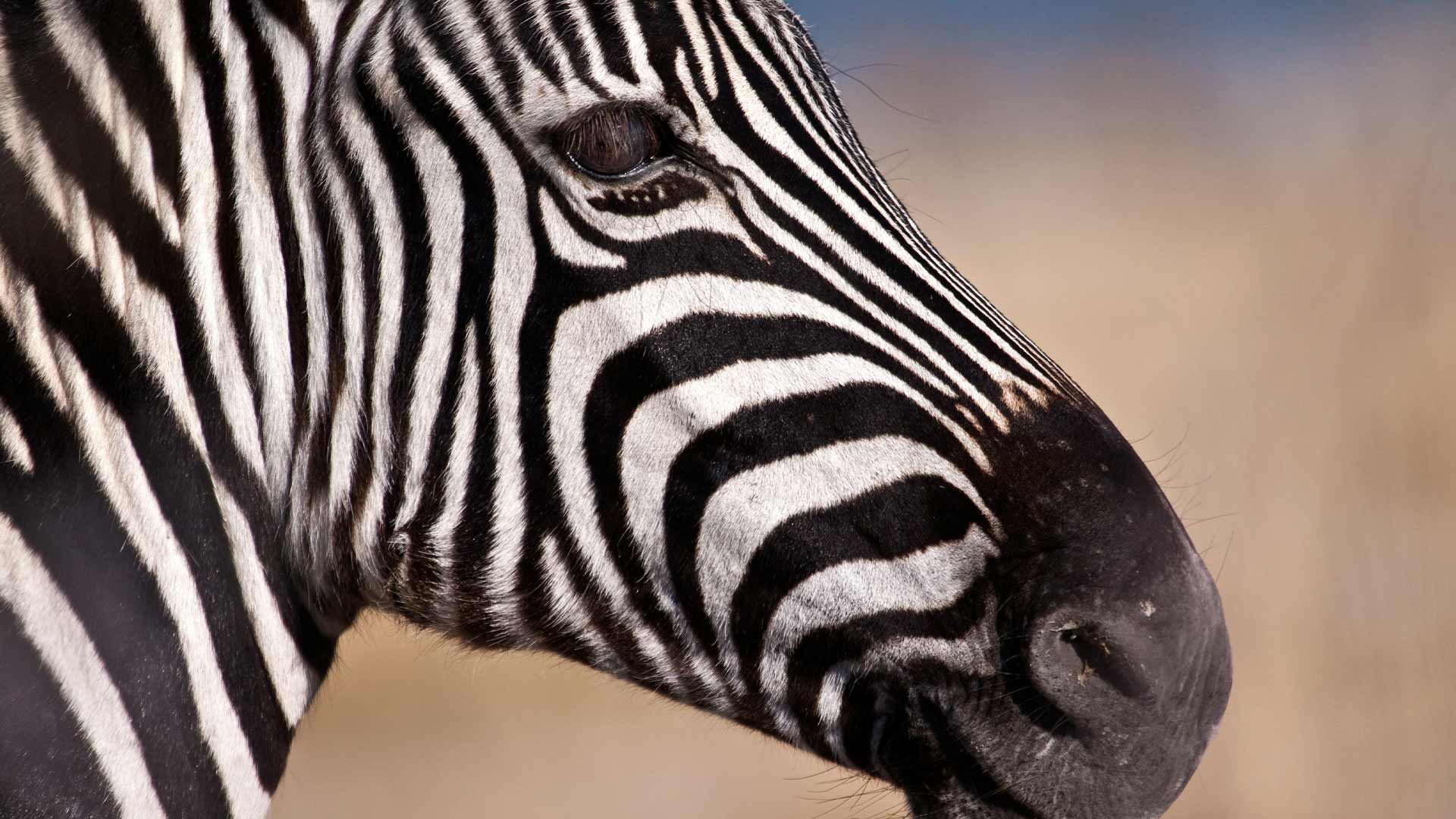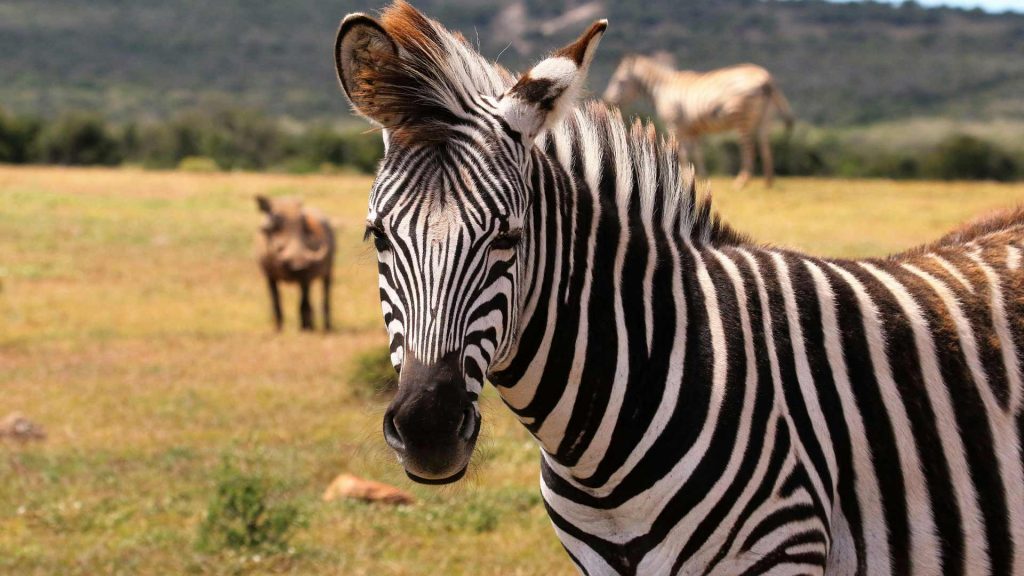Zebra
Zebras, native to Africa’s savannas, are famed for their unique black-and-white stripes. Learn about their description, behaviour, habitat, and geographical distribution.

Overview
The zebra, scientifically known as Equus quagga, is one of Africa’s most iconic animals, recognized for its distinctive black and white striped coat. Zebras belong to the horse family, Equidae, and are primarily found in the savannas and grasslands of Africa.
Species in Africa
- Plains Zebra (Equus quagga): The most common species, found in a variety of habitats from savannas to woodlands.
- Mountain Zebra (Equus zebra): Adapted to mountainous regions, with a more robust body and a dewlap under the neck.
- Grévy’s Zebra (Equus grevyi): The largest and most endangered species, with narrow stripes and a white belly, primarily found in semi-arid regions of Kenya and Ethiopia.
Scientific Classification
- Kingdom: Animalia
- Phylum: Chordata
- Class: Aves (Birds)
- Order: Perissodactyla
- Family: Equidae
- Genus: Equus
- Species: Equus quagga (Plains zebra), Equus zebra (Mountain zebra), Equus grevyi (Grévy's zebra)
Description
Zebras are medium-sized herbivores with a distinctively patterned coat that serves as a camouflage mechanism and a means of social identification. The stripes of each zebra are unique, much like human fingerprints. This variation helps zebras recognize each other and may also deter predators by creating a confusing visual pattern when they move in a herd.
- Size: Zebras typically stand about 1.2 to 1.5 meters (3.9 to 4.9 feet) tall at the shoulder.
- Weight: They weigh between 350 to 450 kilograms (770 to 990 pounds).
- Coat: The pattern and density of stripes vary among species and individuals. Plains zebras have broader stripes that continue onto the belly, while mountain zebras have narrower stripes and a white belly.
Physical Characteristics
Head and Face
Zebras have a long, angular face with large, dark eyes positioned on the sides of their head, providing a wide field of vision. Their ears are large and can rotate to capture sounds from different directions, aiding in predator detection.
Legs and Hooves
They have slender, muscular legs with solid hooves that are well-suited for running at high speeds, which is crucial for escaping predators. Their legs also have distinct stripes that can confuse predators when zebras move in a herd.
Mane
The mane of a zebra is short and stands erect, running from the top of the head down to the shoulders. It is also striped, adding to their overall camouflage.
Tail
The tail is relatively short with a tuft of hair at the end, which they use to swat away insects.

Behavior, Diet, Reproduction, and Lifespan
Behaviour
Zebras are highly social animals, living in family groups called harems or larger herds. Each harem typically consists of one stallion, several mares, and their offspring. Zebras communicate through vocalizations, facial expressions, and body postures.
Social Structure
- Harems: A harem is led by a single dominant male, called a stallion, who guards his group of mares and their foals. The stallion is responsible for defending the group from predators and rival males.
- Bachelor Groups: Young males who have not yet acquired a harem often form bachelor groups. These groups provide safety in numbers and a social structure that prepares them for future leadership roles.
- Large Herds: Multiple harems and bachelor groups can come together to form large herds, especially in areas with abundant resources. These herds can number in the hundreds, providing increased vigilance against predators.
Communication
- Vocalizations: Zebras produce various sounds, including barks, brays, and snorts, to communicate different messages. For example, a loud bray can signal alarm, while softer snorts may indicate contentment.
- Body Language: Ears pinned back can signal aggression or discomfort, while ears forward indicate curiosity or attentiveness. Tail movements also convey different states of mind; a relaxed tail signifies calmness, while a tail held high indicates excitement or alertness.
Diet
Zebras are grazers, primarily feeding on grasses, although they may occasionally consume leaves and bark. Their digestive system allows them to extract nutrients from low-quality forage, making them well-adapted to their environment.
Feeding Bahaviour
- Grazing: Zebras spend a significant portion of their day grazing. They have a specialized digestive system with a large cecum and colon that efficiently process fibrous plant material.
- Water Dependency: While zebras can survive on low-quality forage, they need regular access to water. They often migrate in response to the availability of water sources, which can be scarce during dry seasons.
Reproduction and Lifespan
Reproduction: Zebras breed throughout the year, but there is often a peak during the rainy season. After a gestation period of about 12 to 14 months, a single foal is born. The foal is able to stand and walk shortly after birth, and it stays close to its mother for protection and nourishment. The bond between the mare and her foal is strong, and the mare fiercely defends her young from threats.
In the wild, zebras live for about 20 to 25 years, while in captivity, they can live up to 40 years.
Habitat and Geographical Distribution
Habitat
Zebras inhabit a range of environments, including savannas, grasslands, woodlands, and mountainous regions. They are highly adaptable and can survive in areas with varying vegetation and water availability.
Habitat Preferences
- Plains Zebras: Prefer open grasslands and savannas where they can easily spot predators.
- Mountain Zebras: Inhabit mountainous and hilly terrain, which provides refuge from predators and harsh weather.
- Grévy’s Zebras: Adapted to arid and semi-arid regions, often found in scrublands and grassy plains.
Geographical Distribution
Zebras are widely distributed across the diverse landscapes of Eastern and Southern Africa, inhabiting a variety of environments that range from the vast savannas to mountainous regions. Each zebra species has adapted to specific habitats, contributing to their widespread presence across multiple countries and national parks.
In Kenya, zebras are a prominent feature in iconic wildlife reserves such as the Maasai Mara and Samburu National Reserve. The Maasai Mara, known for its breathtaking wildebeest migration, is also home to large herds of plains zebras that graze the expansive grasslands. Samburu National Reserve, with its semi-arid landscape, provides a haven for the endangered Grévy’s zebra, which thrives in the arid conditions of Northern Kenya.
Tanzania boasts some of the most famous wildlife sanctuaries where zebras can be observed in their natural habitat. The Serengeti National Park, a UNESCO World Heritage site, is renowned for its abundant wildlife, including vast herds of plains zebras that migrate annually in search of fresh grazing. The Ngorongoro Crater, another UNESCO site, is a unique ecosystem that supports a high density of zebras alongside other wildlife, offering a spectacular setting for zebra observation.
In Botswana, zebras are commonly found in Chobe National Park and the Okavango Delta. Chobe National Park, located in the northern part of the country, is famous for its large elephant population, but it also hosts significant numbers of plains zebras. The Okavango Delta, a unique inland delta, provides a lush and diverse habitat for zebras, especially during the flood season when the delta transforms into a mosaic of waterways and islands.
South Africa is home to numerous protected areas where zebras can be seen. Kruger National Park, one of the largest game reserves in Africa, is a prime destination for observing zebras in their natural environment. Addo Elephant National Park, initially established to protect elephants, has expanded its conservation efforts to include other species, providing a sanctuary for zebras as well.
Namibia offers the rugged beauty of Etosha National Park, where zebras are a common sight. The park’s salt pans and savannas create a unique landscape that supports a variety of wildlife, including both plains and mountain zebras. The mountain zebras, in particular, are well-adapted to the arid and rocky terrain of Namibia.
Ethiopia is a crucial region for the conservation of Grévy’s zebras. Awash National Park, located in the Great Rift Valley, provides a critical habitat for these rare zebras. The park’s semi-arid conditions and diverse flora support the survival of Grévy’s zebras, making it an important conservation site in Eastern Africa.
In Uganda, zebras are commonly found in Lake Mburo National Park. This park, situated in the western part of the country, features a mix of savannas, woodlands, and wetlands that create an ideal habitat for zebras. The park’s diverse ecosystem supports a healthy population of plains zebras, along with other wildlife species.
Zambia is another key location for zebra populations, with South Luangwa National Park being a notable habitat. This park, located in the eastern region of Zambia, is famous for its walking safaris and abundant wildlife, including significant numbers of zebras that thrive in its varied landscapes.
In Mozambique, zebras inhabit Gorongosa National Park, a conservation success story that has seen the resurgence of wildlife populations after years of civil conflict. The park’s restoration efforts have created a safe haven for zebras and other species, making it an emerging destination for wildlife tourism.
Zimbabwe offers several national parks where zebras can be observed, including Hwange National Park and Mana Pools National Park. Hwange, the largest game reserve in Zimbabwe, supports large herds of plains zebras that roam its extensive grasslands. Mana Pools, a UNESCO World Heritage site, provides a unique setting for zebra observation along the Zambezi River.
Conservation
Zebras face several threats, including habitat loss, hunting, and competition with livestock. Conservation efforts are crucial to ensure their survival, particularly for the endangered Grévy’s zebra. Organizations and governments are working together to establish protected areas, enforce anti-poaching laws, and promote sustainable land-use practices.
Facts
Interesting facts about The Zebra.
The stripes serve multiple purposes, including camouflage, social identification, and deterrence of biting insects.
Zebras use vocalizations, such as barks and whinnies, along with body language like ear positioning and tail movements to communicate.
Lions, hyenas, leopards, and cheetahs are the primary predators of zebras.
Zebras defend themselves by staying in groups, which provides safety in numbers. They use their powerful hind legs to kick predators, and their sharp hooves can cause significant injury. Zebras also run in a zigzag pattern when chased, making it harder for predators to catch them.
Zebras roll in the dust to coat their skin with a layer of dirt, which helps protect them from insect bites and parasites. This behavior, known as dust bathing, also helps to remove loose hair and dead skin, keeping their coat in good condition.
Zebras sleep standing up and typically only lie down for deep sleep when they are in groups and feel safe from predators. They have a stay apparatus in their legs that allows them to lock their knees and sleep while standing without falling over.
The social structure of a zebra herd, or harem, typically consists of one dominant stallion, several mares, and their offspring. The stallion defends the harem from predators and rival males, while the mares form strong bonds and often groom each other to strengthen social ties. Larger groups can form when multiple harems come together, particularly in areas with abundant resources.
Zebras groom each other using their teeth to remove parasites and dead skin, which helps maintain their coat and stripes. This mutual grooming behavior, known as allo-grooming, not only keeps their stripes clean but also strengthens social bonds within the herd.
Zebras use their stripes to communicate with each other. The unique pattern of stripes helps individuals recognize one another, which is particularly important in maintaining the social bonds within a herd. Mothers can identify their foals and vice versa, and the contrast of stripes is thought to help signal different behaviors or moods.
While zebras do not have formal alliances, they often graze alongside wildebeests and antelopes. This mixed-species herding offers mutual benefits, such as increased vigilance against predators.
Other Animals
Explore fauna in Africa.






